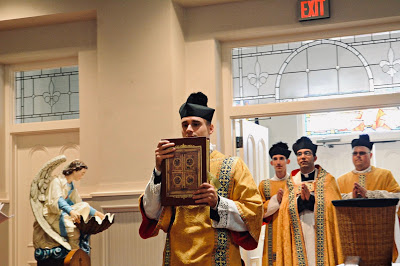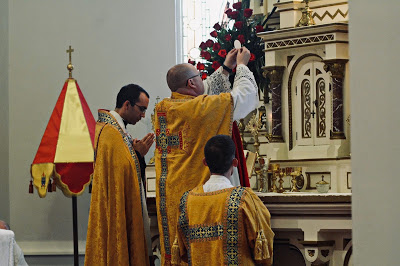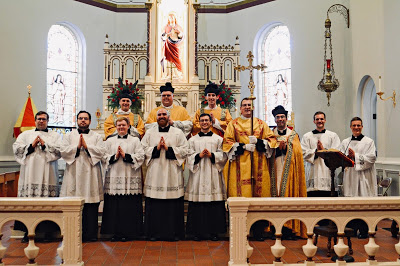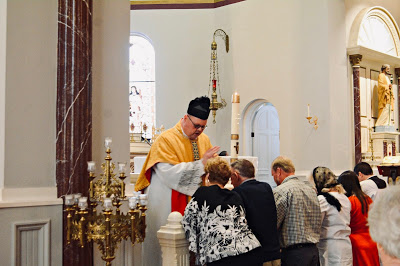Sollemnitas
Ant. ad introitum
Benedíctus sit Deus Pater,
unigenitúsque Dei Fílius,
Sanctus quoque Spíritus,
quia fecit nobíscum misericórdiam suam.
Dicitur Glória in excélsis.
Collecta
Deus Pater, qui, Verbum veritátis
et Spíritum sanctificatiónis mittens in mundum,
admirábile mystérium tuum homínibus declárasti,
da nobis, in confessióne veræ fídei,
ætérnæ glóriam Trinitátis agnóscere,
et Unitátem adoráre in poténtia maiestátis.
Per Dóminum.
Dicitur Credo.
Super oblata
Sanctífica, quǽsumus, Dómine Deus noster,
per tui nóminis invocatiónem,
hæc múnera nostræ servitútis,
et per ea nosmetípsos tibi pérfice munus ætérnum.
Per Christum.
Præfatio: De mysterio Sanctissimæ Trinitatis.
V. Dóminus vobíscum.
R. Et cum spíritu tuo.
V. Sursum corda.
R. Habémus ad Dóminum.
V. Grátias agámus Dómino Deo nostro.
R. Dignum et iustum est.
Vere dignum et iustum est, æquum et salutáre,
nos tibi semper et ubíque grátias ágere:
Dómine, sancte Pater, omnípotens ætérne Deus:
Qui cum Unigénito Fílio tuo et Spíritu Sancto
unus es Deus, unus es Dóminus:
non in uníus singularitáte persónæ,
sed in uníus Trinitáte substántiæ.
Quod enim de tua glória, revelánte te, crédimus,
hoc de Fílio tuo,
hoc de Spíritu Sancto,
sine discretióne sentímus.
Ut, in confessióne veræ sempiternǽque Deitátis,
et in persónis propríetas,
et in esséntia únitas,
et in maiestáte adorétur æquálitas.
Quem laudant Angeli atque Archángeli,
Chérubim quoque ac Séraphim,
qui non cessant clamáre cotídie, una voce dicéntes:
Sanctus, Sanctus, Sanctus Dóminus Deus Sábaoth…
Ant. ad communionem Gal 4,6
Quóniam autem estis fílii,
misit Deus Spíritum Fílii sui in corda vestra
clamántem: Abba, Pater.
Post communionem
Profíciat nobis ad salútem córporis et ánimæ,
Dómine Deus noster, huius sacraménti suscéptio,
et sempitérnæ sanctæ Trinitátis
eiusdémque indivíduæ Unitátis conféssio.
Per Christum.
© Copyright – Libreria Editrice Vaticana
Messalino in PDF con letture in lingua italiana (da stampare su fogli A3 fronte/retro)


























